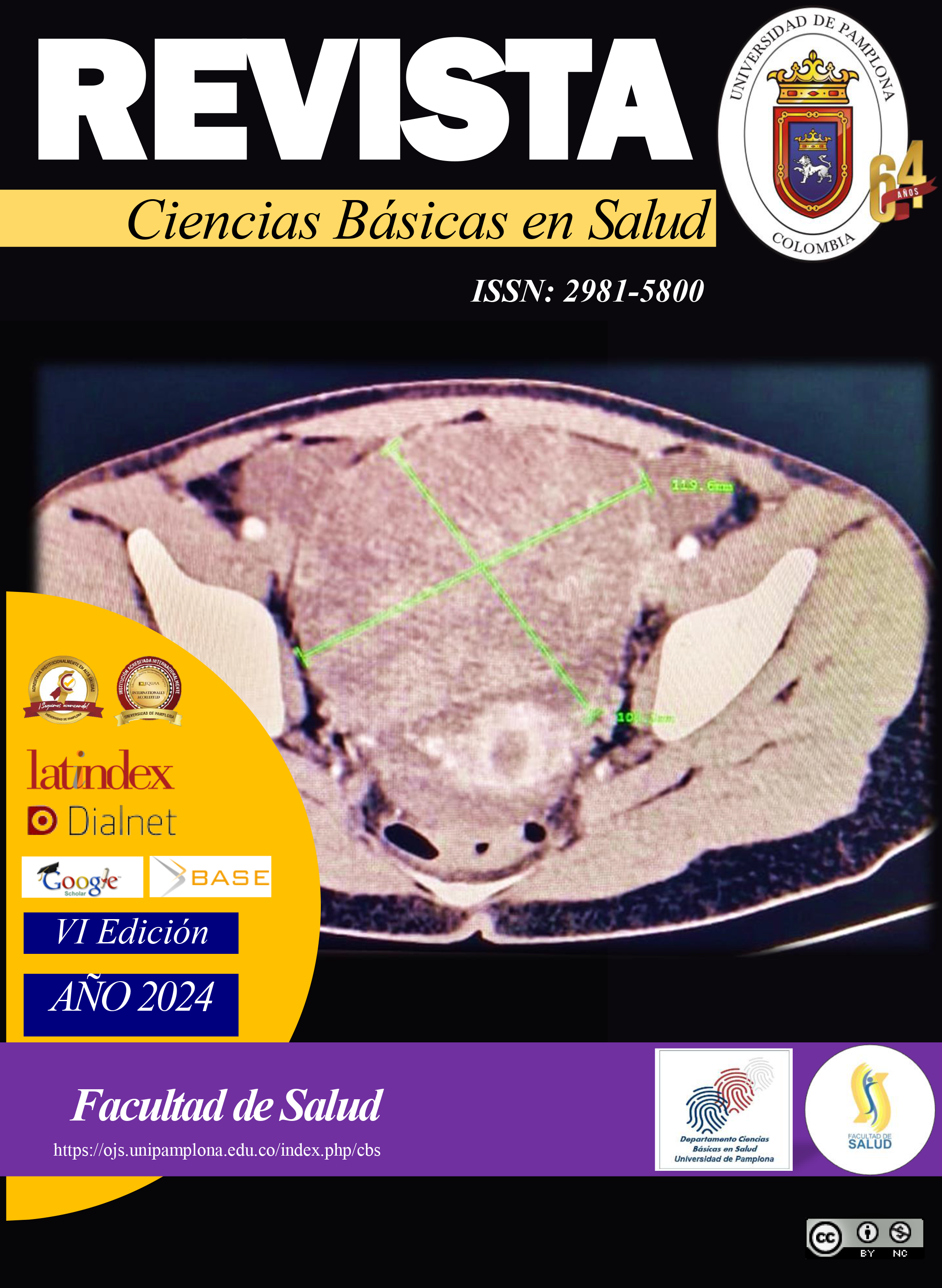Factores socioculturales que influyen a la no toma de citología en mujeres del área rural y urbana del municipio de San Gil
DOI:
https://doi.org/10.24054/cbs.v2i4.3287Palabras clave:
cáncer de cuello uterino, citología, factores de riesgo, servicios de saludResumen
Introducción: En Colombia el cáncer de cuello uterino es una de las patologías con mayor incidencia y mortalidad. Objetivo: Determinar los factores que influyen en a la no toma de citología del área rural y urbana del municipio de San Gil. Metodología: Es un estudio de tipo cuantitativo con un diseño analítico, descriptivo y transversal, con una muestra de 175 mujeres del municipio de San Gil, se aplicó la encuesta nacional de demografía y salud (ENDS-2010) de Profamilia, es una investigación sin riesgo, donde se escogieron por variables como mayores de 18 años, residentes del área rural y urbana, que no se han realizado la citología y que firmaron el consentimiento informado. Resultados: se encontró que los factores que influyen a la no toma de citología son los factores psicológicos como miedo/temor (10,9%) y factor educativo haciendo referencia al no tener vida sexual activa con (5,1%) y debido a su edad creían que no era necesario y porque nunca les explicaron que era importante (3,4%). Encontrando así un (56,6%) de mujeres que se realizaron la citología y un (43,4%) que nunca se la han realizado. Conclusiones: Se determinaron diversos factores predisponentes a la no toma de la citología como lo son factores psicológicos, educativos, en la relación a estos factores, las mujeres del área rural tienen menor asistencia sanitaria, en las cuales se puede evidenciar la falta de conocimientos y en las mujeres del área urbana hay mayor asistencia sanitaria, la mayoría cumplen con el esquema 1-1-3 que es debidamente planteado en el sistema de salud.
Descargas
Referencias
Aldave-Zamora, A, & Apolaya-Segura, M. (2019). Factores asociados al incumplimiento del despistaje oportuno con papanicolaou en la detección temprana del cáncer de cérvix en un centro poblado rural. Acta Médica Peruana, 36(4), 259-266. http://www.scielo.org.pe/scielo.php?script=sci_arttext&pid=S1728-59172019000400003&lng=es&tlng=pt.
Beltrán Gómez, V. M., & Guzmán Vega, N. M. (2023). Factores socioculturales que influyen en la toma de citología en mujeres de 18 a 49 años que consultan en Clínica Pro-Vida, Nejapa, San Salvador, Marzo a Agosto 2023 (Doctoral dissertation, Universidad de El Salvador).
Castillo-Ávila, I. Y., Bohórquez-Moreno, C. E., & Hernández-Bello, L. S. (2019). Variables socio-sanitarias asociadas al uso adecuado de la citología cervico-uterina en mujeres del área rural-Cartagena. Duazary, 16(2), 20-30.
Grupo de Epidemiología y Demografía de la Secretaría de Salud de Santander. (2020). El cáncer de mama puede ser detectado tempranamente y tratado de forma efectiva. https://historico2.santander.gov.co/index.php/actualidad/item/5200-el-cancer-de-mama-puede-ser-detectado-tempranamente-y-tratado-de-forma-efectiva
Instituto Nacional de Cancerología. (2018). Boletín epidemiológico. Recuperado de https://www.cancer.gov.co/files/libros/archivos/BoletinSIVIGILA. (2019) Boletín epidemiológico semana 38. Colombia. 2019. http://www.santander.gov.co/index.php/documentos-salud/send/2139-2019/18069-boletin-epidemiologico-semanal-no-38-de-2019
Instituto Nacional de Cancerología. (2021) Guía de Práctica Clínica para la detección y manejo de las pacientes con lesiones preneoplásicas de cérvix. https://www.cancer.gov.co/recursos_user/Gu%C3%ADas-y-Protocolos/Recomendaciones_GPC_lesiones_preneopl%C3%A1sicas_de_c%C3%A9rvix.pdf
Instituto nacional de salud. (2018). Cáncer de mama y cuello uterino. https://www.ins.gov.co/buscador-eventos/BoletinEpidemiologico/2018%20Bolet%C3%ADn%20epidemiol%C3%B3gico%20semana%2023.pdf
Jaramillo, C., Fabara, G., & Falcón, R. (2020). Evaluación Calidad de Atención y Satisfacción del Usuario en Consulta Externa (Hospital General Docente Ambato). 593 Digital Publisher CEIT, 5(6), 4-23.
Ministerio de Salud y Protección Social. (1993, octubre 4). Ley 8430 de 1993: Por la cual se establecen las normas científicas, técnicas y administrativas para la investigación en salud. https://www.minsalud.gov.co/sites/rid/Lists/BibliotecaDigital/RIDE/DE/DIJ/RESOLUCION-8430-DE-1993.PDF
Ministerio de Salud. (2015). Afiliación En Salud Decreto 2353 de 2015. SGSSS: Sistema General de Seguridad Social en Salud. https://www.minsalud.gov.co/sites/rid/Lists/BibliotecaDigital/RIDE/DE/COM/abece-afiliacion-salud.pdf
Ministerio de Salud. (2019). Cáncer de cuello uterino. https://www.minsalud.gov.co/salud/publica/ssr/Paginas/Cancer-de-cuello-uterino.aspx
Ministerio de Salud. (2019). Cáncer de cuello uterino. https://www.minsalud.gov.co/salud/publica/ssr/Paginas/Cancer-de-cuello-uterino.aspx
Observatorio Nacional de cáncer. (2024). Cáncer de cuello de uterino. https://www.sispro.gov.co/observatorios/oncancer/Paginas/info_general_cuellouterino.aspx
Organización Panamericana de la Salud. (2018). Una estrategia mundial para la eliminación del cáncer de cervicouterino. https://www.paho.org/es/fin-cancer-cervicouterino
Organización Panamericana de la Salud/Organización Mundial de la Salud. (2019). Plan de acción sobre la prevención y el control del cáncer cervicouterino 2018-2030. Washington. https://www.paho.org/es/documentos/plan-accion-sobre-prevencion-control-cancer-cervicouterino-2018-2030-0
Organización Panamericana de la Salud/Organización Mundial de la Salud. (2017). Avances en la prevención y el control del cáncer de cuello uterino. Washington. https://www.paho.org/hq/index.php?option=com_content&view=article&id=13746:countries-report-progress-on-preventing-controlling-cervical-cancer&Itemid=42440&lang=es
Profamilia. (2019). Encuesta Nacional de Demografía y Salud - ENDS 2015. https://profamilia.org.co/wp-content/uploads/2019/05/ENDS-2015-TOMO-II.pdf
Programa de Naciones Unidas para el Desarrollo. (2020). Objetivos de Desarrollo del Milenio. Objetivos de desarrollo sostenible. https://www.undp.org/content/undp/es/home/sdgoverview/mdg_goals.html
Saldaña Téllez, M., Montero, M., & López, L. (2017). Barreras percibidas por el personal de salud para la toma de la citología cervical en mujeres zapotecas. Juchitán – Oaxaca. http://www.psicologiadramontero.com/Publicaciones/files/2017/Saldana_Montero_2017.pdf
Urdaneta, J. R., Castillo, Y., Zambrano, N. B., Maggiolo, I., Levy, A., & Romero, Z. (2023). Adherencia Al Tamizaje De Cáncer De Cuello Uterino Mediante Citología Cérvico-Vaginal: Opinión De Mujeres Venezolanas. Revista Venezolana de Oncología, 35(2), 74-92.
Descargas
Publicado
Número
Sección
Licencia
Derechos de autor 2024 Revista Ciencias Básicas en Salud

Esta obra está bajo una licencia internacional Creative Commons Atribución-NoComercial 4.0.







